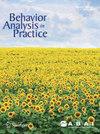自闭症儿童广义指示语框架库的发展。
IF 1.7
Q2 PSYCHOLOGY, CLINICAL
Behavior Analysis in Practice
Pub Date : 2024-12-04
eCollection Date: 2025-03-01
DOI:10.1007/s40617-024-01017-w
引用次数: 0
摘要
本研究采用跨行为设计的多重基线评估了关系训练对一个八岁自闭症男孩三种指示框架库(I/You, Now/Then, Here/There)建立的有效性。关系训练在三种直接训练和相互依存的指示关系的建立上都是有效的,但在刺激函数的转换上存在差异。研究结果支持了先前的研究结果,系统地开发了与同一参与者的多种类型的视角。本文章由计算机程序翻译,如有差异,请以英文原文为准。
Development of a Generalized Deictic Framing Repertoire in an Autistic Child.
The current study evaluated the effectiveness of relational training on the establishment of three deictic framing repertoires (I/You, Now/Then, Here/There) in an eight-year-old autistic boy using a multiple baseline across behaviors design. Relational training was effective in establishing all three directly trained and mutually entailed deictic relations, while differences were observed in transformation of stimulus function. Results support previous findings with the systematic development of multiple types of perspective taking repertoires with the same participant.
求助全文
通过发布文献求助,成功后即可免费获取论文全文。
去求助
来源期刊

Behavior Analysis in Practice
PSYCHOLOGY, CLINICAL-
自引率
18.20%
发文量
94
期刊介绍:
Behavior Analysis in Practice, an official journal of the Association for Behavior Analysis International, is a peer-reviewed translational publication designed to provide science-based, best-practice information relevant to service delivery in behavior analysis. The target audience includes front-line service workers and their supervisors, scientist-practitioners, and school personnel. The mission of Behavior Analysis in Practice is to promote empirically validated best practices in an accessible format that describes not only what works, but also the challenges of implementation in practical settings. Types of articles and topics published include empirical reports describing the application and evaluation of behavior-analytic procedures and programs; discussion papers on professional and practice issues; technical articles on methods, data analysis, or instrumentation in the practice of behavior analysis; tutorials on terms, procedures, and theories relevant to best practices in behavior analysis; and critical reviews of books and products that are aimed at practitioners or consumers of behavior analysis.
 求助内容:
求助内容: 应助结果提醒方式:
应助结果提醒方式:


